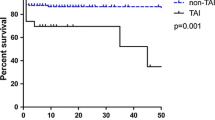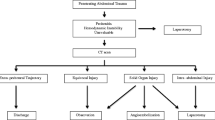Abstract
The aims of this study were to (1) define characteristics for the thoracoabdominal injury patient population; (2) describe sequences of surgical interventions with combined procedures (i.e., thoracotomy and laparotomy); and (3) describe pitfalls leading to inappropriate sequencing of surgical interventions for thoracoabdominal injuries. It was a retrospective 4-year study (January 1995 to December 1998) conducted at an urban level I trauma center. The study population comprised 254 patients who had sustained thoracoabdominal injuries requiring surgical intervention: 187 (73%) gunshot wounds (GSWs), 64 (25%) stab wounds (SWs), and 3 (2%) shotgun wounds (STWs). The mean revised (RTS) was 6.04; the mean Injury Severity Score (ISS) was 27; the mean estimated blood loss (EBL) was 3000 ml. The overall survival was 175 of 254 (69%). Of the 254, 51 (20%) underwent emergency department (ED) thoracotomy. Altogether, 73 (29%) underwent combined thoracotomy and laparotomy: 59 (81%) GSW, 13 (18%) SW, 1 (1%) STW (mean RTS 5.2, mean ISS 34, mean EBL 6800 ml). Overall survival was 30 of these 73 (41%). A total of 21 of the 73 (29%) underwent ED thoracotomy. In group I (laparotomy then thoracotomy: Lap + Thor, n=34) the initial procedure was interrupted in 18 (53%). In group II (thoracotomy then laparotomy: Thor + Lap, n=39) the initial procedure was interrupted in 14 (36%). Pitfalls leading to inappropriate surgical sequencing were persistent hypotension (13/73,18%) and misleading chest tube output (8/73,10%). It was concluded that penetrating thoracoabdominal injuries incur high mortality (31%), and the mortality doubles for patients who require combined procedures (59%). Inappropriate surgical sequencing occurred in 32 of 73 (44%) patients undergoing combined procedures. Persistent hypotension, indicating that the wrong cavity was accessed, and misleading chest tube output are the leading pitfalls in thoracoabdominal injury management.
Résumé
Objectifs: 1) Définir les caractéristiques des traumatisés thoracoabdominaux 2) Décrire la séquence idéale d’interventions chirurgicales lorsque plus d’une opération est nécessaire (i.e., thoracotomie et laparotomie) chez ces patients; 3) décrire les erreurs qui peuvent conduire à une séquence opératoire inappropriée en cas de lésions thoracoabdominales combinées. Méthodes: Dans une étude rétrospective entre janvier 1995 et décembre 1998 (4 ans), dans un Trauma center urbain niveau I, on a relevé 254 patients ayant eu une lésion combinée thoracoabdominale nécessitant une intervention chirurgicale. Résultats: 1) Il y a eu 187 (73%) plaies par balles (GSW), 64 (25%) plaies par arme blanche (SW) et 3 (2%) plaies par fusil de chasse (STW). Les scores et valeurs moyens du «revised trauma score» (RTS), de l’«injury severity score» (ISS), et l’«estimated blood loss» (EBL) ont été, respectivement, de 6,04, de 27, et de 3000 ml. La survie globale a été de 175/254 (69%). 51/254 (20%) ont eu une thoracotomie d’urgence en salle d’urgences. 2) 73/254 (29%) ont eu une thoracotomie et une laparotomie: 59 (81%) par GSW, 13 (18%) par SW, 1 (1%) par STW. Les scores et valeurs moyens RTS, ISS, EBL ont été, respectivement, de 5,2, de 34 et de 6800 ml. La survie globale a été de 30/73 (41%). 21/73 (29%) ont eu une thoracotomie en salle d’urgences. Dans la séquence laparotomie suivie de thoracotomie (groupe I), on a du interrompre l’intervention initiale pour changer de cavité chez 18/34 (53%) patients. Dans la séquence thoracotomie suivie de laparotomie (groupe II), on a du interrompre le procédé initial pour changer de cavité chez 14/39 (36%). 3) Les erreurs amenant à pratiquer une séquence inappropriée ont été: une hypotension persistante chez 13/73 (18%), un drainage thoracique faussement interprété chez 8/73 (10%). Conclusions: 1) La mortalité des traumatismes thoraco-abdominaux pénétrants est élevée—31%. La mortalité est doublée chez les patients ayant besoin de deux voies d’abord—59%. 2) Une séquence inappropriée a été enregistrée chez 32/73 (44%) patients; 3) Une hypotension persistante indicative d’une hémorragie et un drainage du tube thoracique faussement interprété sont les cause principales de séquence inappropriée dans le traitement de lésions thoracoabdominales combinées.
Resumen
Objetivos: 1) Definir las caracteristicas de los pacientes con traumatismo toracoabdominal. 2) Describir la secuencia de las intervenciones quirúrgicas en abordajes combinados p. ej. toracotomía y laparotomía. 3) Descubrir los errores que inducen a una secuencia inapropiada de las intervenciones quirúrgicas en traumatizados toracoabdominales. Métodos: Estudio retrospectivo de 4 años (1/95–12/98) en un centro traumatológico urbano de nivel I. 254 pacientes con traumatismos toracoabdominales requirieron tratamiento quirúrgico. Resultados: 1) Se registraron 187 (73%) heridas por bala (GSW), 64 (25%) por arma blanca (SW) y 3 (2%) heridas por perdigones (STW). Puntuación media en la escala RTS=6.04, en la ISS=27 y la media de la pérdida sanguinea estimada (EBL)=3.000 ml. Supervivencia global 175/254 (69%). 51/254 (20%) sufrieron toracotomies ED. 2) A 73/254 (29%) se les practicó una toracotomÍa y laparotomÍa combinadas; en 59 (81%) por GSW 13 (18%) por SW y 1 (1%) por STW. Puntuación media en las escalas RTS=5.2 y ISS=34, media de la pérdida sanguÍnea estimada (EBL)=6.800 mL Supervivencia total 30/73 (41%), 21/73 (29%) sufrieron una toracotomÍa ED. Grupo I: laparotomÍzados y después toracotomizados (Lap-Thor)—34, en 18/34 (53%) el abordaje inicial se interrumpió. Grupo II: toracotomÍa y después laparotomÍa (Thor y Lap)—39, en 14/39 (36%) se interrumpió el abordaje quirúrgico inicial. 3) Los errores que indujeron a una inapropiada secuencia operatoria fueron: hipotensión persistente 13/73 (18%) y erronéa valoración de la cantidad drenada por el tubo intratorácico 8/73 (10%). Conclusiones: 1) Los traumatismo toracoabdominales penetrantes (abiertos) conllevan una mortalidad elevada (31%). La mortalidad se duplica en aquellos pacientes que requieren intervenciones combinadas (59%). 2) Una secuencia inapropiada del abordaje quirúrgico se observó en 32/73 pacientes sometidos a intervenciones combinadas. 3) La hipotensión persistente (evidencia que se ha accedido a la cavidad equivocada) y la errónea valoración del flujo del drenaje torácico constituyen los errores principales en el tratamiento de los traumatismos toracoabdominales.
Similar content being viewed by others
References
Hirshberg A, Wall MJ, Jr., Allen MK, Mattox K. Double jeopardy: thoracoabdominal injuries requiring surgical intervention in both chest and abdomen. J. Trauma 1995;39:225
Brewer, L.A., III: Thoracoabdominal wounds. In: Thoracic Surgery, vol II: Surgery in World War II, Ahnfeldt, A.L., editor. Washington, D.C., Office of the Surgeon General, Department of the Army, 1965, pp. 101–104
Artz CP, Brownwell AW, Sako Y. Experience in the management of abdominal and thoracoabdominal injuries in Korea. Am. J. Sure. 1955;89:773
McNamara JJ, Messermith JK, Dunn RA. Thoracic injuries in combat casualties in Vietnam. Ann. Thorac. Surg. 1970;10:389
Merlotti GJ, Dillon BC, Lange DA, Robin AP, Barrett JA. Peritoneal lavage in penetrating thoracoabdominal trauma. J. Trauma 1988;28:17
Asensio, J.A., Demetriades, D., Rodriguez, A.: Injuries to the diaphragm: In Trauma, 3rd edition, Feliciano, D.V., Moore, E.E., Mattox, K.L., editors. Norwalk, CT, Appleton & Lange, 1995, pp. 461–485
Murray JA, Berne J, Asensio JA. Penetrating thoracoabdominal trauma. Emerg. Med. Clin. North Am. 1998;16:107
Ferrada R, Garcia A. Penetrating torso trauma. Adv. Trauma Crit. Care 1993:8:85
Mattox KL. Indications for thoracotomy: deciding to operate. Surs. Clin. North Am. 1989;69:47
Murray JA, Demetriades D, Asensio JA. Penetrating left thoracoabdominal trauma: the incidence and clinical presentation of diaphragmatic injuries. J. Trauma 1996;41:509
Borja AR, Ransdeil H. Treatment of thoracoabdominal gunshot wounds in civilian practice: experience with forty four cases. Am. J. Surg. 1971;121:580
Moore JB, Moore EE, Thompson JS. Abdominal injuries associated with penetrating trauma in the lower chest. Am. J. Surg. 1980;140:724
Oparah SS, Mandai AK. Penetrating gunshot wounds of the chest in civilian practice: experience with 250 consecutive cases. Br. J. Surg. 1978;65:45
Hirshberg A, Thomson SR, Blade PG, Huizinga WKJ. Pitfalls in the management of penetrating chest injuries. Am. J. Surg. 1989;157:372
Rotondo MF, Schwab CW, Mc Gonigal MD, Phillips GR. Fruchterman TM, Kauder DR, Latenser B, Angood PA. “Damage control”: an approach for improved survival in exsanguinating penetrating abdominal injury. J. Trauma 1993;35:375
Aronoff RJ, Reynolds J, Thal ER. Evaluation of diaphragmatic injuries. Am. J. Surg. 1982;144:671
Burch JM, Ortiz VB, Richardson RJ, Martin RR, Mattox KL, Jordan GL. Abbreviated laparotomy and planned reoperation for critical injured patients. Ann. Surg. 1992;215:476
Author information
Authors and Affiliations
Corresponding author
Additional information
Published Online: November 22, 2001
Rights and permissions
About this article
Cite this article
Asensio, J.A., Arroyo, H., Veloz, W. et al. Penetrating thoracoabdominal injuries: Ongoing dilemma—Which cavity and when?. World J. Surg. 26, 539–543 (2002). https://doi.org/10.1007/s00268-001-0147-8
Issue Date:
DOI: https://doi.org/10.1007/s00268-001-0147-8




